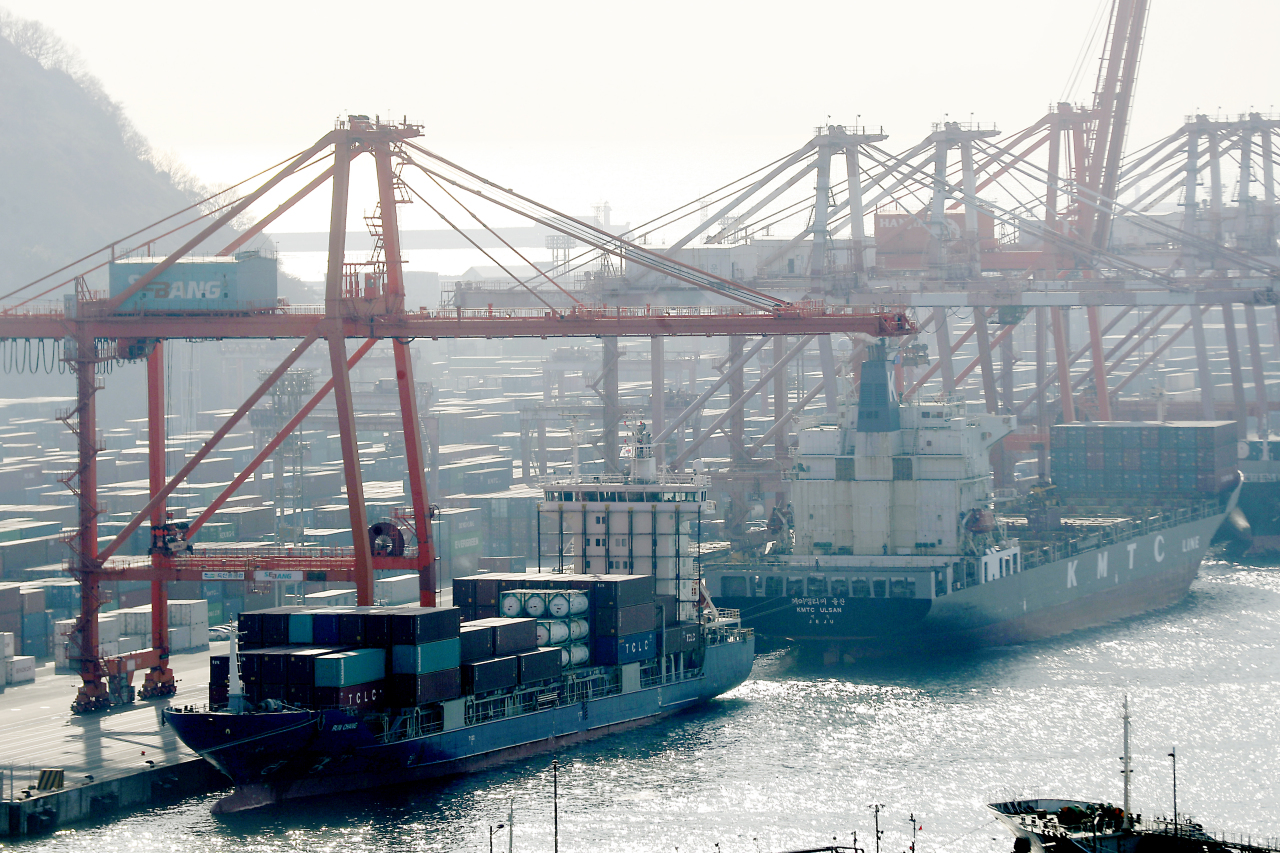 |
This file photo, taken last Tuesday, shows stacks of containers at a port in South Korea's southeastern city of Busan. (Yonhap) |
South Korea's industrial output increased by the most in 17 months in November in the latest sign that economic recovery momentum has been extended despite the pandemic, data showed Thursday.
Industrial output grew 3.2 percent in November from the previous month, a turnaround from a 1.9 percent on-month fall in October, according to the data compiled by Statistics Korea.
It marked the largest on-month gain since June 2020, when industrial output went up 3.9 percent.
The rebound came after industrial output fell by the most in 18 months in October due to fewer working days and global supply chain bottlenecks.
From a year earlier, industrial output rose 5.3 percent in November.
Facility investment grew by the most in seven years last month.
Facility investment added 10.9 percent on-month, compared with a 5 percent decline in October.
But retail sales, a gauge of private spending, declined by the most in 16 months in November due largely to the base effect.
Retail sales fell 1.9 percent on-month last month, compared with a 0.1 percent on-month advance in October.
The decline came even as the country relaxed virus curbs in November under the "living with COVID-19" scheme meant to gradually return to normal life.
The statistics agency said industrial output rebounded on the back of robust production in the manufacturing and service sectors despite a fall in private spending.
"The economic recovery is on track to gain momentum," Eo Woon-sun, a senior Statistics Korea official, told reporters.
In regard to the December data, he said uncertainty remains high as the country tightened virus curbs and consumer sentiment worsened due to the flare-up in virus cases.
Asia's fourth-largest economy is on a recovery track on the back of robust exports and improving private spending.
The country's exports spiked 32.1 percent on-year to hit a record high of $60.44 billion in November, extending their gains to the 13th consecutive month.
Last month, output in the manufacturing sector grew 5.3 percent on the back of an increase in production of autos and chips.
Automobile output jumped 11.3 percent on-month due to an eased shortage of auto chips.
Service output rose 2 percent on-month in November, compared with a 0.4 percent on-month fall. Output in the accommodation and eatery sector rose 5.6 percent due to relaxed antivirus measures and the resumption of discount coupon programs aimed at bolstering spending.
Despite the overall recovery, the South Korean economy faces growing downside risks as the latest upsurge in COVID-19 cases and the spread of the omicron variant are casting a cloud over the recovery of private spending.
South Korea reported 5,409 more coronavirus cases Wednesday, raising the total to 620,938. The number of omicron infections increased 109, bringing the total cases to 558.
To contain the pandemic, the country reimposed tougher antivirus measures on Dec. 18, including lowering the maximum size of private gatherings to four people and restoring curfews on business hours at restaurants and cafes.
"The stricter antivirus measures are feared to hamper domestic demand. The omicron variant, global supply chain strains and rising inflation also serve as risk factors," Finance Minister Hong Nam-ki wrote on his Facebook page.
The South Korean economy grew 0.3 percent in the third quarter from three months earlier, slowing from a 0.8 percent on-quarter gain in the second quarter, according to central bank data.
Private spending contracted 0.2 percent in the July-September period from three months earlier, compared with a 3.6 percent on-quarter gain three months earlier.
The Bank of Korea (BOK) expects the Korean economy to grow 3 percent next year after the estimated 4 percent increase this year.
The Korean government expects 3.1 percent growth for next year.
The finance ministry sharply revised up its 2022 outlook to 2.2 percent from its earlier estimate of 1.4 percent. The BOK forecast consumer prices to grow 2 percent next year. (Yonhap)







![[Today’s K-pop] Blackpink’s Jennie, Lisa invited to Coachella as solo acts](http://res.heraldm.com/phpwas/restmb_idxmake.php?idx=644&simg=/content/image/2024/11/21/20241121050099_0.jpg)
